Monmouth Castle
Last updated| Monmouth Castle | |
|---|---|
Castell Trefynwy | |
| Monmouth, Wales | |
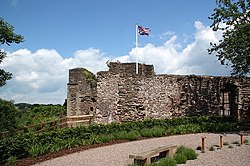 Ruins of the castle | |
| Coordinates | 51°48′45″N2°43′00″W / 51.8125°N 2.7167°W |
| Site information | |
| Condition | Ruin |
| Site history | |
| Built | 1067 |
| Built by | William FitzOsbern, 1st Earl of Hereford |
Listed Building – Grade I | |
Monmouth Castle (Welsh : Castell Trefynwy) is a castle close to the centre of the town of Monmouth, the county town of Monmouthshire, on a hill above the River Monnow in south-east Wales.
Contents
- Early Norman border castle
- Expansion and later use
- Civil War
- Modern history
- Gallery
- References
- Sources
- External links
Once an important border castle, and birthplace of Henry V of England, it stood until the English Civil War when it was damaged and changed hands three times before being slighted to prevent it being fortified again. After partial collapse in 1647, the site was reused and built over by Great Castle House, which became the headquarters and regimental museum of the Royal Monmouthshire Royal Engineers.
It is a Grade I listed building and scheduled monument.
Early Norman border castle
Immediately after the Norman Conquest, William the Conqueror installed three of his most trusted confidants, Hugh d'Avranches, Earl of Chester, Roger of Montgomery, and William FitzOsbern, as the Earls of Chester, Shrewsbury and Hereford respectively. [1] The earldoms served to guard the frontier and provided bases for the Norman invasion of Wales. [1] Over the next four centuries, Norman lords established mostly small Marcher Lordships between the Dee and Severn, and further west. Military adventurers came to Wales from Normandy and elsewhere, raided an area of Wales, and then fortified it and granted land to some of their supporters. [2]
William FitzOsbern established Monmouth Castle between 1066 and 1069 as a counterpart to his other major castle at Chepstow. [1] [3] It occupied relatively high ground, overlooking the confluence of the Monnow with the River Wye. [4] It was originally an earth and timber ringwork fortress, which was listed in the Domesday Book of 1086. [5] Initially, Monmouth was a fairly typical border castle in the Welsh Marches, presided over by a Marcher Lord and similar in style and status to its near neighbours Grosmont Castle, Skenfrith Castle, White Castle and Abergavenny Castle. The wooden castle had stonework added before 1150. [6] Its tower shares some similarities with that of Chepstow Castle, another stronghold built for FitzOsbern further south, at the lower end of the River Wye. [6]
Expansion and later use
After briefly being held by Simon de Montfort, 6th Earl of Leicester, Monmouth Castle passed into the hands of Edmund Crouchback, Earl of Lancaster and son of Henry III in 1267. [7] He redeveloped the castle, building the Hall and took it as his main residence in the area. It was further improved in the early 14th century, probably by Crouchback's grandson, Henry of Grosmont, 1st Duke of Lancaster. [8] During this period large decorated windows were installed in the upper part of the Great Tower which also had a new roof. [6] As a town developed around the castle, the castle's defences were augmented by a town wall and fortified bridge, built at the end of the 13th century. [9]
Edward II briefly was held prisoner in the castle before he was transferred to Berkeley Castle where he died. [10] The castle was a favourite residence of Henry Bolingbroke, later King as Henry IV. It was here that in 1386 the future King Henry V of England was born, to Bolingbroke's first wife Mary de Bohun. [11]
The turmoil and conflict in Wales during the ten years of the Owain Glyndŵr rebellion did not directly affect Monmouth Castle as it was a stronghold of the region and lesser targets presented themselves more readily to essentially a guerilla army. However other local towns, settlements and castles were directly attacked with Grosmont and Abergavenny being razed and Crickhowell Castle and Newport Castle successfully attacked. [12]
Over the centuries, as its defensive function diminished, the outer bailey of the castle became increasingly used as a market place, later (and now) known as Agincourt Square. During the sixteenth century, when Monmouth became the county town of the newly formed shire of Monmouth, the county's Courts of Assize began to be held in the castle's Great Hall. [13]
Civil War

In the tumult of the English Civil War, Monmouth Castle changed hands three times, finally falling to the Parliamentarians in 1645. [15] Oliver Cromwell visited Monmouth in 1646, and according to tradition ordered the slighting (demolition) of the castle. [16] On 1 March 1647, the House of Commons resolved "That the Town and Castle of Monmouth be disgarisoned, and the Works slighted". [17] [18] The demolition process began with the round tower on 30 March 1647. [6] The events were recorded in the diary, now lost, of More Pye, then usher at Monmouth School. The demolition took months, and Pye's diary also recorded the collapse on 22 December 1647; "about twelve o'clock, the Tower in the Castle of Monmouth fell down, upon one side, whilst we were at sermon". [19] William Gilpin, visiting Monmouth on his Wye Tour, described the castle's decline by the end of the 18th century; "The transmutations of time are often ludicrous... formerly the palace of a king, and birth-place of a mighty prince: it is now converted into a yard for fatting ducks". [20]
Great Castle House was built in 1673, on the site of the old round tower, by Henry Somerset, 1st Duke of Beaufort. [6] It is a Grade I listed building, [21] and has been described as "a house of splendid swagger outside and in". [22] It later became used for the Assize Courts, until they relocated to the new Shire Hall in 1725. [23]
Modern history
Only fragments of the castle, including the Great Tower and Hall and parts of the walls, remain above ground, and on the site Castle House and Great House have been built. In 1875, the Royal Monmouthshire Royal Engineers Militia, the senior Army Reserve regiment today, made it their Headquarters building and so it remains. It is one of the few British castles in continuous military occupancy. [24] The Royal Monmouthshire Royal Engineers museum is located in the stable block attached to Great Castle House. It includes exhibits relating to the history of the regiment from 1539 to the present day. [25]
The castle is a Grade I listed building [26] and a scheduled monument in the care of Cadw. [27]
Gallery
- Architectural plan of Monmouth Castle, black and white print, from engraving, 1801
- Early lithograph by George Rowe
- Ruins of the Great Tower
- Mediaeval window in the ruins of the Great Tower
- Monmouth Castle and St Mary's Priory Church, black and white print on engraving, 1800
- Aerial photo of Monmouth Castle and surrounding areas from the west.
Related Research Articles

Monmouth is a town and community in Wales. It is situated where the River Monnow joins the River Wye, two miles from the Wales–England border. Monmouth is 30 miles (50 km) northeast of Cardiff, and 113 miles (182 km) west of London. It is within the Monmouthshire local authority, and the parliamentary constituency of Monmouth. The population in the 2011 census was 10,508, rising from 8,877 in 2001. Monmouth is the historic county town of Monmouthshire although Abergavenny is now the county town.

White Castle, also known historically as Llantilio Castle, is a ruined castle near the village of Llantilio Crossenny in Monmouthshire, Wales. The fortification was established by the Normans in the wake of the invasion of England in 1066, to protect the route from Wales to Hereford. Possibly commissioned by William fitz Osbern, the Earl of Hereford, it comprised three large earthworks with timber defences. In 1135, a major Welsh revolt took place and in response King Stephen brought together White Castle and its sister fortifications of Grosmont and Skenfrith to form a lordship known as the "Three Castles", which continued to play a role in defending the region from Welsh attack for several centuries.

Monmouthshire is a county in the south east of Wales. It borders Powys to the north; the English counties of Herefordshire and Gloucestershire to the north and east; the Severn Estuary to the south, and Torfaen, Newport and Blaenau Gwent to the west. The largest town is Abergavenny, and the administrative centre is Usk.
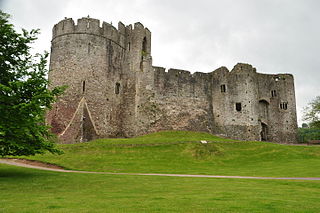
Chepstow Castle at Chepstow, Monmouthshire, Wales is the oldest surviving post-Roman stone fortification in Britain. Located above cliffs on the River Wye, construction began in 1067 under the instruction of the Norman Lord William FitzOsbern. Originally known as Striguil, it was the southernmost of a chain of castles built in the Welsh Marches, and with its attached lordship took the name of the adjoining market town in about the 14th century.

Monnow Bridge, in Monmouth, Wales, is the only remaining fortified river bridge in Great Britain with its gate tower standing on the bridge. Such bridge towers were common across Europe from medieval times, but many were destroyed due to urban expansion, diminishing defensive requirements and the increasing demands of traffic and trade. The historical and architectural importance of the bridge and its rarity are reflected in its status as a scheduled monument and a Grade I listed building. The bridge crosses the River Monnow 500 metres (1,600 ft) above its confluence with the River Wye.
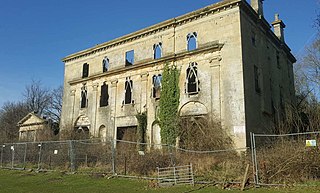
Piercefield House is a largely ruined neo-classical country house near St Arvans, Monmouthshire, Wales, about 1.5 miles (2.4 km) north of the centre of Chepstow. The central block of the house was designed in the very late 18th century, by, or to the designs of, Sir John Soane. It is flanked by two pavilions, of slightly later date, by Joseph Bonomi the Elder. The house sits within Piercefield Park, a Grade I listed historic landscape, that was created in the 18th century as a notable Picturesque estate.

Skenfrith Castle is a ruined castle in the village of Skenfrith in Monmouthshire, Wales. The fortification was established by the Normans in the wake of the invasion of England in 1066, to protect the route from Wales to Hereford. Possibly commissioned by William fitz Osbern, the Earl of Hereford, the castle comprised earthworks with timber defences. In 1135, a major Welsh revolt took place and in response King Stephen brought together Skenfrith Castle and its sister fortifications of Grosmont and White Castle to form a lordship known as the "Three Castles", which continued to play a role in defending the region from Welsh attack for several centuries.
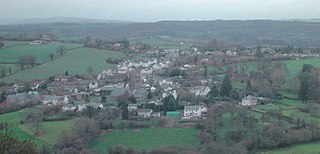
Grosmont is a village and community near Abergavenny in Monmouthshire, Wales. The population taken at the 2011 census was 920. The wider community (parish) includes the villages of Llangattock Lingoed, Llangua and Llanvetherine.

Grosmont Castle is a ruined castle in the village of Grosmont, Monmouthshire, Wales. The fortification was established by the Normans in the wake of the invasion of England in 1066, to protect the route from Wales to Hereford. Possibly commissioned by William fitz Osbern, the Earl of Hereford, it was originally an earthwork design with timber defences. In 1135, a major Welsh revolt took place, and in response King Stephen brought together Grosmont Castle and its sister fortifications of Skenfrith and White Castle to form a lordship known as the "Three Castles", which continued to play a role in defending the region from Welsh attack for several centuries.

Llantilio Crossenny is a small village and much larger former community, now in the community of Whitecastle, in Monmouthshire, south east Wales, in the United Kingdom. It is situated between the two towns of Abergavenny and Monmouth on the B4233 road. The community included Penrhos, and Llanvihangel-Ystern-Llewern.

The Shire Hall in Agincourt Square, Monmouth, Wales, is a prominent Grade I listed building in the town centre. It was built in 1724, and was formerly the centre for the Assize Courts and Quarter Sessions for Monmouthshire. In 1839–40, the court was the location of the trial of the Chartist leader John Frost and others for high treason for their part in the Newport Rising. The building was also used as a market place. The Shire Hall is owned by Monmouthshire County Council and has audiovisual guides for visitors to Courtroom 1. It is currently used as a Tourist Information Centre and as the offices for Monmouth Town Council, and is open to the public in part.

The Church of St Thomas the Martyr at Overmonnow, Monmouth, south east Wales, is located beside the medieval Monnow Bridge across the River Monnow. At least part of the building dates from around 1180, and it has a fine 12th-century Norman chancel arch, though the exterior was largely rebuilt in the early 19th century. It is one of 24 buildings on the Monmouth Heritage Trail and is a Grade II* listed building.

St Mary's Priory Church, in Whitecross Street, Monmouth, Monmouthshire, Wales, is an Anglican church founded as a Benedictine priory in 1075. The current church dates mostly from the 18th and 19th centuries. It was designated a Grade II* listed building in 1952. It is one of 24 buildings on the Monmouth Heritage Trail.

Chapel House, Hereford Road, Monmouth, Wales, is a Georgian townhouse, built in the early eighteenth century, described by the architectural historian John Newman, as "the best house in the entire street". The house was designated a Grade II* listed building on 27 June 1952. Chapel House is now a boarding house of Monmouth School.
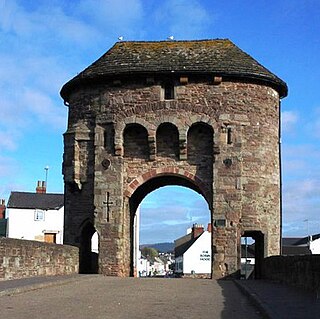
The Monmouth town walls and defences comprise the defensive system of town walls and gates built in Monmouth, Wales between 1297 and the early part of the following century. Wye Bridge Gate, East Gate, Monk's Gate, and Monnow Bridge Gate were access points to the town. West Gate, across Monnow Street, also provided access. Only the Monnow Bridge Gatehouse survives intact, albeit in a substantially modified version from the original.

Monmouthshire is a county and principal area of Wales. It borders Torfaen and Newport to the west; Herefordshire and Gloucestershire to the east; and Powys to the north. The largest town is Abergavenny, with the other major towns being Chepstow, Monmouth, and Usk. The county is 850 km2 in extent, with a population of 95,200 as of 2020. The present county was formed under the Local Government (Wales) Act 1994, which came into effect in 1996, and comprises some sixty percent of the historic county. Between 1974 and 1996, the county was known by the ancient title of Gwent, recalling the medieval Welsh kingdom. In his essay on local government in the fifth and final volume of the Gwent County History, Robert McCloy suggests that the governance of "no county in the United Kingdom in the twentieth century was so transformed as that of Monmouthshire".

St Cenedlon's is a parish church in the village of Rockfield, Monmouthshire, Wales. The dedication to St Cenedlon is unusual and the history of the saint is obscure. Some sources suggest that she was a daughter of Brychan king of Brycheiniog while others identify her as the wife of King Arthfael ab Ithel, king of Glywysing. The existing church dates from the Middle Ages but only the tower remains from that period. After the English Reformation, the surrounding area of north Monmouthshire became a refuge for Catholics and Matthew Pritchard (1669-1750), Roman Catholic bishop and Vicar Apostolic of the Western District is buried at the church. By the mid-19th century the church was in ruins and a complete reconstruction was undertaken by the ecclesiastical architects John Pollard Seddon and John Prichard in around 1860. St Cenedlon's is an active parish church in the Diocese of Monmouth. It is designated by Cadw as a Grade II listed building.
The Three Castles was a former medieval lordship, comprising the fortifications of Grosmont, Skenfrith and White Castle in Monmouthshire, Wales. The castles were established by the Normans in the wake of their conquest of England in 1066, to protect the route from Wales to Hereford. Possibly commissioned by William fitz Osbern, the Earl of Hereford, they initially comprised earthwork fortifications with timber defences. In 1135, a major Welsh revolt took place and in response King Stephen brought the castles together to form the lordship, which continued to play a role in defending the region for several centuries.

Perth-hir House, Rockfield, Monmouthshire, Wales, was a major residence of the Herbert family. It stood at a bend of the River Monnow, to the north-west of the village. At its height in the 16th century, the mansion, entered by two drawbridges over a moat, comprised a great hall and a number of secondary structures. Subsequently in the ownership of the Powells, and then the Lorimers, the house became a centre of Catholic recusancy following the English Reformation. By the 19th century, the house had declined to the status of a farmhouse and it was largely demolished in around 1830. Its ruins, and the site which contains considerable remnants of a Tudor garden, are a scheduled monument.

Monmouthshire is a county and principal area of Wales. It borders Torfaen and Newport to the west; Herefordshire and Gloucestershire to the east; and Powys to the north. The largest town is Abergavenny, with other large settlements being Chepstow, Monmouth, and Usk. The present county was formed under the Local Government (Wales) Act 1994, which came into effect in 1996. It has an area of 850 km2 (330 sq mi), with a population of 93,200 as of 2021. Monmouthshire comprises some sixty per cent of the historic county, and was known as Gwent between 1974 and 1996.
References
- 1 2 3 Carpenter 2004, p. 110.
- ↑ Lieberman 2008, p. ?.
- ↑ Prior 2006, p. 123.
- ↑ Newman 2000, p. 394.
- ↑ "Monmouth", Open Domesday, King William I of England, archived from the original on 23 December 2012, retrieved 2 January 2012
- 1 2 3 4 5 "Monmouth Castle". Castles Wales. Retrieved 31 December 2011.
- ↑ Salter 2002, pp. 32–33.
- ↑ Kenyon 2010, p. 125.
- ↑ Monnow Bridge at Structurae
- ↑ "Monmouth Castle Ruins". The Castle and Regimental Museum. Archived from the original on 14 April 2012. Retrieved 31 December 2011.
- ↑ Allmand 2010, p. 12952.
- ↑ Matthews 1910, p. 236.
- ↑ Newman 2000, p. 400.
- ↑ Armitage 1904, facing page 168.
- ↑ "Monmouth". Historic Landscape Characterisation. Glamorgan-Gwent Archaeological Trust. Retrieved 31 December 2011.
- ↑ Evans 1953, p. 416.
- ↑ ""House of Commons Journal Volume 5: 1 March 1647," in Journal of the House of Commons: Volume 5, 1646-1648". British History Online. London: His Majesty's Stationery Office. 1802. pp. 101–102. Retrieved 12 July 2021.
- ↑ Rakoczy 2007, p. 392.
- ↑ Whittle 1992, pp. 104–105.
- ↑ Gilpin 2005, p. 38.
- ↑ Cadw. "Great Castle House (Grade I) (2217)". National Historic Assets of Wales . Retrieved 24 August 2020.
- ↑ Newman 2000, pp. 400–401.
- ↑ Bly 2012, p. 9.
- ↑ "Lower Wye Valley". Glamorgan-Gwent Archaeological Trust. Retrieved 15 June 2018.
- ↑ "The Castle and Regimental Museum". Monmouth Castle Museum. Retrieved 31 December 2011.
- ↑ Cadw. "Monmouth Castle (Grade I) (2216)". National Historic Assets of Wales . Retrieved 24 August 2020.
- ↑ Cadw. "Monmouth Castle (MM159)". National Historic Assets of Wales . Retrieved 24 August 2020.
Sources
- Allmand, Christopher (September 2010). "10.1093/ref:odnb/12952". Oxford Dictionary of National Biography (online ed.). Oxford University Press. doi:10.1093/ref:odnb/12952.(Subscription or UK public library membership required.)
- Armitage, Ella S. (1904). "The Early Norman Castles of England. Part I". The English Historical Review. 19 (74): 209–245. doi:10.1093/ehr/XIX.LXXIV.209.
- Bly, Phil (2012). Guide to the complete Monmouth Heritage Blue Plaque Trail. Monmouth: Monmouth Civic Society. OCLC 797974800.
- Carpenter, David (2004). The Struggle for Mastery: Britain 1066-1284. London: Penguin Books. ISBN 0-14-014824-8.
- Evans, C. J. O. (1953). Monmouthshire: Its History and Topography. William Lewis Ltd.
- Gilpin, William (2005) [1782]. Observations on the River Wye. London: Pallas Athene. ISBN 978-1843-68197-7. OCLC 1118261174.
- Kenyon, John R. (2010). The Medieval Castles of Wales. Cardiff: University of Wales Press. ISBN 978-0-7083-2180-5. OCLC 693942235.
- Lieberman, Max (2008). The March of Wales, 1067-1300: a borderland of medieval Britain. Cardiff: University of Wales Press. ISBN 978-0-7083-2115-7.
- Matthews, James (1910). Historic Newport. Newport-on-Usk: The William Press Limited.
- Newman, John (2000). Gwent/Monmouthshire. The Buildings of Wales. London: Penguin. ISBN 0-14-071053-1.
- Prior, Stuart (2006). A Few Well Positioned Castles: The Norman Art of War. Tempus. ISBN 0-7524-3651-1.
- Rakoczy, Lila (2007). Archaeology of Destruction: A Reinterpretation of Castle Slightings in the English Civil War (PhD thesis). University of York. OCLC 931130655.
- Salter, Mike (2002). Castles of Gwent, Glamorgan and Gower. Malvern, UK: Folly Publications. ISBN 9781871731613. OCLC 54947157.
- Whittle, Elisabeth (1992). Glamorgan and Gwent. A Guide to Ancient and Historic Wales. London: HMSO. ISBN 9780117012219. OCLC 473187732.
External links
Text is available under the CC BY-SA 4.0 license; additional terms may apply.
Images, videos and audio are available under their respective licenses.






